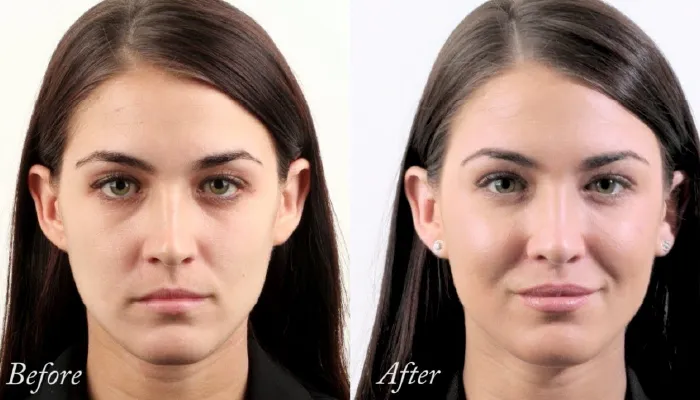- Our temples are located on either side of the head, between the forehead and the ears, and as a natural part of the ageing process, the breakdown of collagen can cause a loss of volume to the area. This can result in a sunken, hollow appearance that can prematurely age the face.
- A loss of volume in the temple area can add shadows and hollows that age your upper face. Many people don’t realize that it is not only possible to have the temple area treated with dermal fillers, but that it is also a very effective way to give your face a more youthful appearance. By using dermal fillers to add definition and volume to your temple area, we can help to highlight your eyes and banish those unwanted shadows.
- Temple fillers are the classic treatment for volume loss in the upper face. As we age, our temples lose volume, creating a very hollow look. It is easy to replace the volume loss in the temples with dermal filler or with biostimulator. The reduction in volume of the temples causes that loss of roundness which typically starts in the mid-20s and becomes really obvious in the 40s.
- Temple filler treatments could solve a multitude of concerns brought about by ageing. A youthful face has lots of fullness, and much of this could be due to the structure of the temporal region. This is the area just below the sides of our forehead. There is very little volume within this area, and ageing means we could lose some of what little volume is there. We could also lose volume from the forehead. Lines and wrinkles may appear deeper and more visible there, making us look older and more stressed.
- Temple and forehead dermal fillers consist of injections of clear hyaluronic acid gel in small amounts. These are injected into your temporal areas or forehead, so the gel adds volume to the area, giving a smooth appearance to the skin while reducing lines, restoring shape and giving contour to the face.
- Forehead fillers can reduce the ‘worry’ lines across your forehead, giving you a smooth appearance, reduce the hollows that appear with ageing, reduce the shadowing effect on both eyes and face, lift the face.
- Using dermal fillers, we can deliver fast, effective and non-invasive natural results that will last up to 12 months. To do this, we’ll administer a small amount of dermal filler into precise points on your temples to plump up and restore volume and add definition to the overall area. Temple filler can also help to lift and tighten skin and soften the look of fine lines and wrinkles that appear around the eyes.
- Dermal Fillers are the key to rejuvenating temples. By carefully refilling the hollows of the temples they become less prominent. The treatment contours the face to create the illusion of slightly higher cheekbones that blend seamlessly upwards into the forehead and brow. By increasing temple volume, the face looks softer and less drawn. It also allows for better visibility of the outer edge of your brow, which would otherwise disappear around the side of your face due to volume loss.
- Dermal fillers are made of hyaluronic acid which is a natural substance found in the body. An appropriate type of dermal filler with just the right viscosity and thickness will be selected for the injection. A topical numbing cream is first applied to the temples.
- Rejuvenation of the temples involves a simple procedure of 1-2 tiny injections of temple filler per side. Depending on the amount of volume lost, on average 1-2cc of filler would be required to fill up sunken temples.
- A full and smooth temple can smoothen the contours of the face and give you a more youthful appearance. Temple fillers typically last between 12-24 months*
- As the filler contains lignocaine, a numbing agent, the procedure is made much more comfortable. There is basically no downtime with fillers. Some possible side effects include slight swelling or bruising but this typically resolves quickly.
- The longevity of a dermal filler depends on the type of filler used, the age of the patient, the amount of filler used and the area of filler placement.
- +60 12-636 0170
- info@klinikfinesse.com









